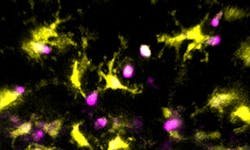Two-photon microscopy approach captures video of how T-cells operate
A team of immunologists at The University of Texas at Austin (Austin, TX) has captured on video how T-cells (the cells responsible for destroying bacteria and viruses) learn what do before they get unleashed in the body. Two-photon microscopy, the imaging technique that allowed for the videos, holds promise for the fight against autoimmune disorders such as Type 1 diabetes.
One of the human body's most potent weapons against many diseases is the T-cell, but in people with autoimmune disorders, T-cells also wreak havoc by mistaking normal cells for invaders and attacking healthy parts of the body. "T-cells have the daunting task of recognizing and fighting off all of the diverse pathogens that we encounter throughout our lives, while avoiding attacking our own healthy tissue," says associate professor Lauren Ehrlich, one of the authors of the study. "These cells mature in the thymus, an organ just above the heart, where they 'get educated' to not attack the body."
Ehrlich and postdoctoral researcher Jessica Lancaster captured video of this process in a mouse thymus. Using a pair of powerful lasers that fire in short pulses and scan through a slice of live tissue every 15 seconds to reconstruct the positions, movements, and intracellular signaling of cells, they observed that as T-cells develop, other cells in the thymus help them to encounter all sorts of ordinary human proteins that, later on, the T-cells will need to ignore to avoid attacking other parts of the body. The researchers learned more about how different types of cells work together in the thymus to perform the safety tests and, in the event a T-cell fails, trigger it to self-destruct.
Related: Two-photon microscopy shows how immune cells attack lymphoma cells
Ehrlich says studying T-cells with this imaging technique holds promise for improvements for human health that will depend on a better understanding of what's happening in the thymus. For example, patients who received bone-marrow transplants endure weeks or months with suppressed immune systems and a higher risk for developing autoimmune disorders, and people with Type 1 diabetes have T-cells that often attack the cells in the pancreas that produce insulin.
Full details of the work appear in the journal Nature Communications.
